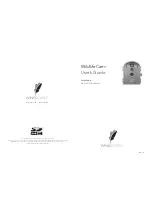
2-6
|
ni.com
Chapter 2
Power and I/O
Communicating with the Console
When the CONSOLE DIP switch is in the ON position, you can read device information from
the NI Smart Camera during startup, such as the IP address and firmware version, through a
serial port terminal program. Ensure that the serial port terminal program is configured to the
following settings:
•
9,600 bits per second
•
Eight data bits
•
No parity
•
One stop bit
•
No flow control
Connecting to a Quadrature Encoder
This section applies only to the following NI Smart Cameras:
•
NI 1742
•
NI 1744
•
NI 1762
•
NI 1764
Connect RS-422 compatible differential quadrature encoders to the NI 17xx Smart Camera to
provide positional information. A quadrature encoder uses two output channels, Phase A and
Phase B, to track the position of a rotary shaft. Generally, the shaft is coupled to a motor drive
that controls the movement of an object. By providing Phase A and Phase B signals to the smart
camera, you can obtain a precise measurement of the object position. Using a quadrature encoder
gives you the ability to specify your trigger delay in terms of positional units—such as inches or
centimeters, after applying the resolution information of your encoder—rather than time.
National Instruments does
not
recommend the use of single-ended encoders with the smart
camera. This configuration would require the ground for a single-ended encoder to be connected
to the COM pin of the smart camera, and the PhaseA- and PhaseB- signals would be left
unconnected. In this configuration, the system is susceptible to significant noise that would be
eliminated by using a differential encoder.
Shielded encoder cables are recommended for all applications. Unshielded cables are more
susceptible to noise and can corrupt the encoder signals.
Refer to the
External Trigger
section of Chapter 5,
Image Acquisition
, for information about
using a quadrature encoder to delay a trigger.
















































